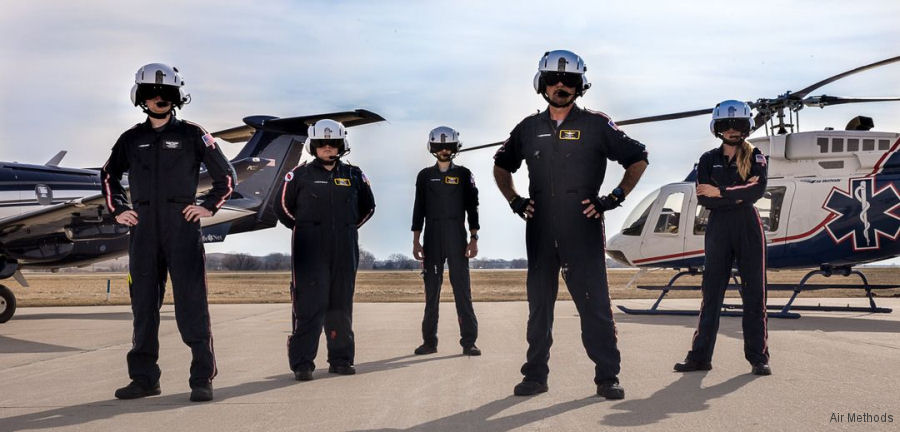
Air Methods, June 24, 2021 - The already-delicate rural healthcare system is severely off-kilter with no indication of returning to pre-COVID normalcy.
For rural hospitals, which generally exist on thin margins even in the best of times, the situation has only grown more dire.
Just this year, at least 14 rural hospitals have closed in the U.S.
This has incredibly adverse effects on population health and patient outcomes, as a 2019 study found that “death rates in the communities increase by nearly 6% after a rural hospital closes.” As we move towards recovery, it’s imperative that the 60 million people living in rural areas of the U.S. have timely access to care and that this care is adequately covered by payers.
Looking at ways we can restructure the healthcare landscape to be prepared for the next pandemic, air medical services have continued to make a difference for rural populations in several ways, including shortening time and distance to care, enabling safer transfers between trauma and specialty centers, and extending the capabilities of rural hospitals.
Shortening time and distance to care: Not only are rural hospitals disappearing, those that remain are often underfunded and understaffed, leaving them poorly equipped to treat certain patients. The lack of healthcare access due to geographic location is only exacerbated by this lack of capacity and resources.
In these scenarios, which are becoming more and more common, patients must be transported to more advanced facilities, such as trauma centers that are better equipped to treat their conditions. A major barrier to those facilities is distance: a ground ambulance may require hours of driving to reach the rural hospital, while an air ambulance may cover the same distance in under an hour.
Enabling safer transfer between trauma and specialty centers: Approximately 85 million Americans live more than an hour from a Level I or Level II trauma center if driven by a conventional ground ambulance. Without air medical transport service, these people, who represent 25% of the U.S. population, cannot access lifesaving trauma services in a timely manner.
Air ambulances are staffed with paramedics and nurses who can perform important care for trauma patients, which a rural hospital staff may not be familiar with delivering. Air medical service extends the reach of hospitals and specialty centers, preserving access to these lifesaving facilities for millions of Americans in rural areas.
Extending the capabilities of rural hospitals: Given the rapid closures and widespread vulnerabilities experienced by rural hospitals, air ambulances effectively serve as flying emergency rooms with lifesaving equipment and highly trained staff who treat patients in the air during critical moments helping rural hospitals improve outcomes.
Ensuring Adequate Coverage: Emergency air medical services are a low-volume yet integral component of the healthcare system, serving approximately one out of every 1,000 Americans annually. It is crucial that the healthcare industry remains focused on delivering access to care for the 60 million rural Americans. Rest assured that air medical services will continue to represent an essential lifeline for rural communities.
For rural hospitals, which generally exist on thin margins even in the best of times, the situation has only grown more dire.
Just this year, at least 14 rural hospitals have closed in the U.S.
This has incredibly adverse effects on population health and patient outcomes, as a 2019 study found that “death rates in the communities increase by nearly 6% after a rural hospital closes.” As we move towards recovery, it’s imperative that the 60 million people living in rural areas of the U.S. have timely access to care and that this care is adequately covered by payers.
Looking at ways we can restructure the healthcare landscape to be prepared for the next pandemic, air medical services have continued to make a difference for rural populations in several ways, including shortening time and distance to care, enabling safer transfers between trauma and specialty centers, and extending the capabilities of rural hospitals.
Shortening time and distance to care: Not only are rural hospitals disappearing, those that remain are often underfunded and understaffed, leaving them poorly equipped to treat certain patients. The lack of healthcare access due to geographic location is only exacerbated by this lack of capacity and resources.
In these scenarios, which are becoming more and more common, patients must be transported to more advanced facilities, such as trauma centers that are better equipped to treat their conditions. A major barrier to those facilities is distance: a ground ambulance may require hours of driving to reach the rural hospital, while an air ambulance may cover the same distance in under an hour.
Enabling safer transfer between trauma and specialty centers: Approximately 85 million Americans live more than an hour from a Level I or Level II trauma center if driven by a conventional ground ambulance. Without air medical transport service, these people, who represent 25% of the U.S. population, cannot access lifesaving trauma services in a timely manner.
Air ambulances are staffed with paramedics and nurses who can perform important care for trauma patients, which a rural hospital staff may not be familiar with delivering. Air medical service extends the reach of hospitals and specialty centers, preserving access to these lifesaving facilities for millions of Americans in rural areas.
Extending the capabilities of rural hospitals: Given the rapid closures and widespread vulnerabilities experienced by rural hospitals, air ambulances effectively serve as flying emergency rooms with lifesaving equipment and highly trained staff who treat patients in the air during critical moments helping rural hospitals improve outcomes.
Ensuring Adequate Coverage: Emergency air medical services are a low-volume yet integral component of the healthcare system, serving approximately one out of every 1,000 Americans annually. It is crucial that the healthcare industry remains focused on delivering access to care for the 60 million rural Americans. Rest assured that air medical services will continue to represent an essential lifeline for rural communities.

Healthcare services for the 60 million rural Americans
See also |




